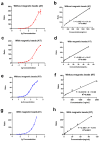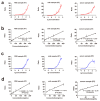Establishment and Comparison of Detection Methods for Ricin and Abrin Based on Their Depurination Activities
- PMID: 40278675
- PMCID: PMC12031163
- DOI: 10.3390/toxins17040177
Establishment and Comparison of Detection Methods for Ricin and Abrin Based on Their Depurination Activities
Abstract
Ricin (RT) and abrin (AT) are plant toxins extracted from Ricinus communis and Abrus precatorius, respectively, and both have N-glycosidase activity. The detection of these toxins is vital because of their accessibility and bioterrorism potential. While ricin can be effectively detected based on its depurination activity, only a few tests are available for detecting the depurination activity of abrin. Therefore, it is unclear whether they share the same optimal reaction substrate and conditions. Here, we established optimum depurination conditions for ricin and abrin, facilitating the in vitro detection of their depurination activity using high-performance liquid chromatography-tandem mass spectrometry. The parameters optimized were the reaction substrate, bovine serum albumin (BSA), buffer, pH, temperature, time, antibodies, and magnetic beads. Both toxins showed better depurination with single-stranded DNA. However, substrate length, adenine content, BSA concentration, buffer concentration, reaction temperature, and reaction time differed between the two toxins. The optimal conditions for ricin depurination involved a reaction in 1 mM ammonium acetate solution (0.5 μM DNA15A, 20 μg/mL BSA, and 1 mM Zn2+, with pH 4.0) at 55 °C for 1 h. The optimal conditions for abrin depurination involved a reaction in 1 mM ammonium citrate solution (0.2 μM DNA20A, 10 μg/mL BSA, 1 mM Mg2+, and 0.5 mM EDTA, with pH 4.0) at 45 °C for 2 h. After optimization, the limits of detection (LOD) for ricin and abrin were 0.506 ng/mL and 0.168 ng/mL, respectively. The detection time was also significantly reduced.
Keywords: HPLC–MS/MS; N-glucosidase activity; abrin; detection; ricin.
Conflict of interest statement
The authors declare no conflicts of interest.
Figures







Similar articles
-
[Highly toxic type Ⅱ ribosome-inactivating proteins ricin and abrin and their detection methods: a review].Se Pu. 2021 Mar;39(3):260-270. doi: 10.3724/SP.J.1123.2020.10001. Se Pu. 2021. PMID: 34227307 Free PMC article. Review. Chinese.
-
Quantitative profiling of the in vivo enzymatic activity of ricin reveals disparate depurination of different pulmonary cell types.Toxicol Lett. 2016 Sep 6;258:11-19. doi: 10.1016/j.toxlet.2016.06.003. Epub 2016 Jun 11. Toxicol Lett. 2016. PMID: 27298272
-
Differentiation, Quantification and Identification of Abrin and Abrus precatorius Agglutinin.Toxins (Basel). 2021 Apr 18;13(4):284. doi: 10.3390/toxins13040284. Toxins (Basel). 2021. PMID: 33919561 Free PMC article.
-
Mass Spectrometric Detection and Differentiation of Enzymatically Active Abrin and Ricin Combined with a Novel Affinity Enrichment Technique.Chem Res Toxicol. 2024 Jul 15;37(7):1218-1228. doi: 10.1021/acs.chemrestox.4c00149. Epub 2024 Jul 4. Chem Res Toxicol. 2024. PMID: 38963334 Free PMC article.
-
The history of ricin, abrin and related toxins.Toxicon. 2004 Sep 15;44(4):361-70. doi: 10.1016/j.toxicon.2004.05.003. Toxicon. 2004. PMID: 15302520 Review.
References
-
- Eric A.E.G. Toxicity and detection of ricin and abrin in beverages. J. Food Prot. 2008;71:1875–1883. - PubMed
Publication types
MeSH terms
Substances
Grants and funding
LinkOut - more resources
Full Text Sources

